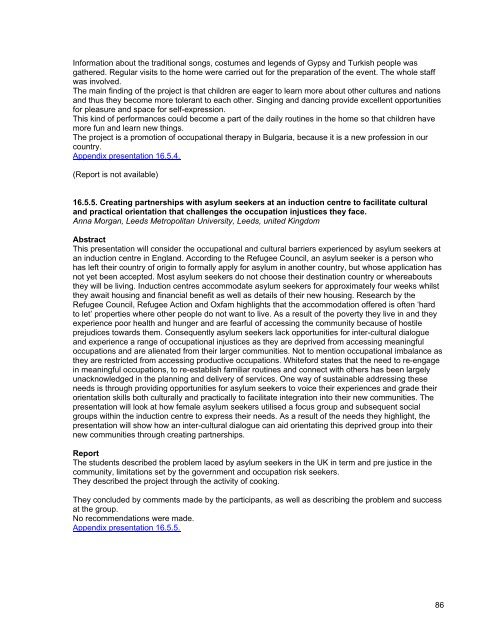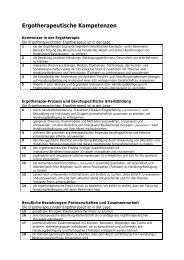Alice Salomon Fachhochschule Hellersdorf Berlin ... - ENOTHE
Alice Salomon Fachhochschule Hellersdorf Berlin ... - ENOTHE
Alice Salomon Fachhochschule Hellersdorf Berlin ... - ENOTHE
You also want an ePaper? Increase the reach of your titles
YUMPU automatically turns print PDFs into web optimized ePapers that Google loves.
Information about the traditional songs, costumes and legends of Gypsy and Turkish people was<br />
gathered. Regular visits to the home were carried out for the preparation of the event. The whole staff<br />
was involved.<br />
The main finding of the project is that children are eager to learn more about other cultures and nations<br />
and thus they become more tolerant to each other. Singing and dancing provide excellent opportunities<br />
for pleasure and space for self-expression.<br />
This kind of performances could become a part of the daily routines in the home so that children have<br />
more fun and learn new things.<br />
The project is a promotion of occupational therapy in Bulgaria, because it is a new profession in our<br />
country.<br />
Appendix presentation 16.5.4.<br />
(Report is not available)<br />
16.5.5. Creating partnerships with asylum seekers at an induction centre to facilitate cultural<br />
and practical orientation that challenges the occupation injustices they face.<br />
Anna Morgan, Leeds Metropolitan University, Leeds, united Kingdom<br />
Abstract<br />
This presentation will consider the occupational and cultural barriers experienced by asylum seekers at<br />
an induction centre in England. According to the Refugee Council, an asylum seeker is a person who<br />
has left their country of origin to formally apply for asylum in another country, but whose application has<br />
not yet been accepted. Most asylum seekers do not choose their destination country or whereabouts<br />
they will be living. Induction centres accommodate asylum seekers for approximately four weeks whilst<br />
they await housing and financial benefit as well as details of their new housing. Research by the<br />
Refugee Council, Refugee Action and Oxfam highlights that the accommodation offered is often ‘hard<br />
to let’ properties where other people do not want to live. As a result of the poverty they live in and they<br />
experience poor health and hunger and are fearful of accessing the community because of hostile<br />
prejudices towards them. Consequently asylum seekers lack opportunities for inter-cultural dialogue<br />
and experience a range of occupational injustices as they are deprived from accessing meaningful<br />
occupations and are alienated from their larger communities. Not to mention occupational imbalance as<br />
they are restricted from accessing productive occupations. Whiteford states that the need to re-engage<br />
in meaningful occupations, to re-establish familiar routines and connect with others has been largely<br />
unacknowledged in the planning and delivery of services. One way of sustainable addressing these<br />
needs is through providing opportunities for asylum seekers to voice their experiences and grade their<br />
orientation skills both culturally and practically to facilitate integration into their new communities. The<br />
presentation will look at how female asylum seekers utilised a focus group and subsequent social<br />
groups within the induction centre to express their needs. As a result of the needs they highlight, the<br />
presentation will show how an inter-cultural dialogue can aid orientating this deprived group into their<br />
new communities through creating partnerships.<br />
Report<br />
The students described the problem laced by asylum seekers in the UK in term and pre justice in the<br />
community, limitations set by the government and occupation risk seekers.<br />
They described the project through the activity of cooking.<br />
They concluded by comments made by the participants, as well as describing the problem and success<br />
at the group.<br />
No recommendations were made.<br />
Appendix presentation 16.5.5.<br />
86




